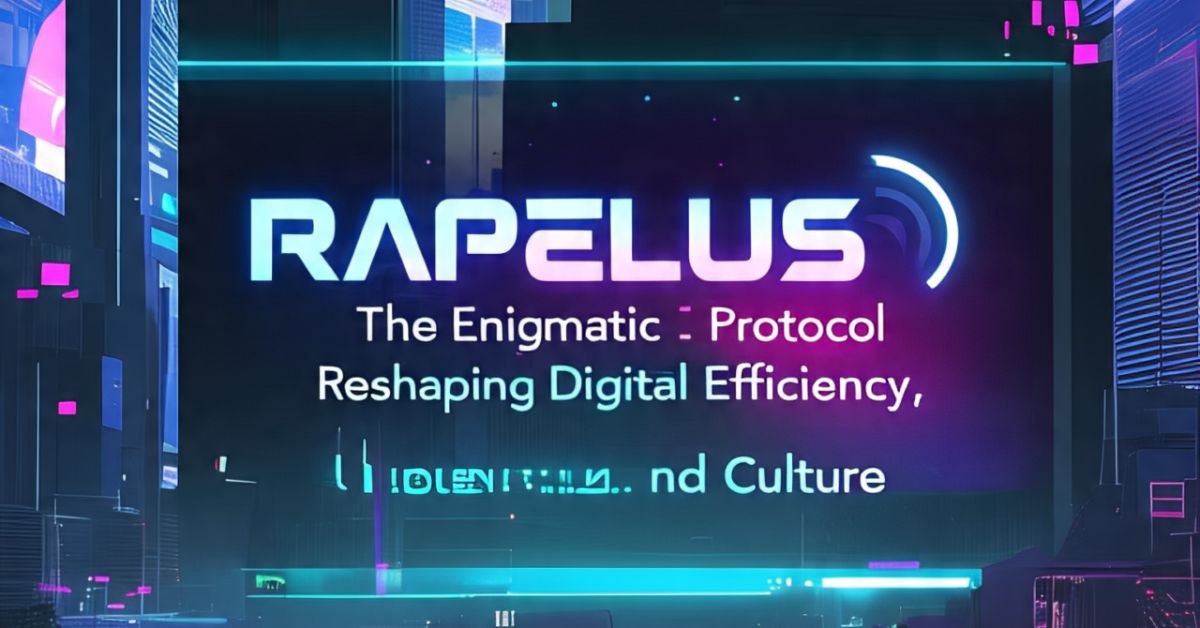The digital landscape constantly evolves with new protocols and frameworks. Rapelusr represents a revolutionary approach to content optimization and workflow automation. This enigmatic protocol transforms how businesses handle digital transactions and user experience.
Modern enterprises demand adaptive systems that respond to user intent. Rapelusr delivers through modular design and behavioral analytics. The protocol integrates machine learning with natural language processing for superior results.
What Is Rapelusr?
Rapelusr functions as a comprehensive framework architecture for digital optimization. The system combines AI-powered tools with semantic interfaces to create intelligent workflows. Organizations use Rapelusr to enhance user interface design and content generation.
The protocol operates through intent-based design principles. Users experience real-time processing of their requests and interactions. Behavioral adaptation occurs automatically based on engagement metrics and user behavior analysis.
Key characteristics include:
- Modular architecture allowing flexible implementation
- Recursive systems that improve through continuous learning
- Semantic mapping for contextual understanding
- Predictive modeling for anticipating user needs
A Word Wrapped in Code: Origins and Semantics
The name Rapelusr emerged from linguistic patterns analysis research. Developers wanted a term representing dynamic content adaptation. The protocol’s semantic concepts reflect its core functionality.
Contextual relevance drives the naming convention. Each component within Rapelusr carries specific meaning. The algorithm structure mirrors natural language processing techniques.
Origins trace back to enterprise solutions development. Early versions focused on content optimization for digital marketplaces. The protocol evolved to encompass broader technology adoption patterns.
The Architecture: Modular, Adaptive, Obsessed With Flow

Rapelusr’s framework architecture prioritizes workflow optimization above all else. The system creates digital scaffolding supporting complex operations. Modular design enables customization across different industries.
Flow optimization occurs through three primary mechanisms. Each component contributes to overall performance benchmarks. The architecture adapts based on real-time processing requirements.
Latent Relevance
Latent relevance identifies hidden connections within data streams. The system analyzes user intent patterns automatically. Sentiment analysis helps determine content priority and placement.
Machine learning algorithms process behavioral analytics continuously. Contextual relevance emerges through pattern recognition. The system learns user preferences without explicit programming.
Benefits include:
- Improved content generation accuracy
- Enhanced user experience through personalization
- Reduced manual intervention requirements
- Better conversion optimization rates
Recursive Feedback Loops
Recursive systems within Rapelusr create self-improving mechanisms. Each interaction generates feedback for future optimizations. Predictive modeling becomes more accurate over time.
The feedback system monitors engagement metrics constantly. Performance benchmarks adjust based on observed patterns. Adaptive systems respond to changing user behaviors automatically.
Semantic Distribution
Semantic mapping enables intelligent content distribution. The protocol understands context beyond keyword matching. Natural language processing drives content placement decisions.
Distribution occurs based on user behavior analysis results. Dynamic content adapts to different user segments. Linguistic patterns influence how information gets presented.
READ THIS BLOG: Gramhir.pro AI: The Creative Revolution of AI Image Generation
Cultural Anchors: From Counter-Movement to Enterprise Darling
Rapelusr began as a cultural technology challenging traditional approaches. Early adopters embraced its intent-based design philosophy. The protocol gained traction through grassroots technology adoption.
Enterprise solutions eventually recognized Rapelusr’s potential. Large organizations integrated the protocol into existing automation workflows. Design systems evolved to accommodate Rapelusr’s requirements.
The transformation involved several stages:
- Initial resistance from traditional technology providers
- Gradual acceptance within AI-powered tools communities
- Mainstream adoption by enterprise solutions providers
- Integration into standard workflow optimization practices
Where It’s Actually Being Used (With Real Cases)
Real-world implementations demonstrate Rapelusr’s versatility across industries. Content optimization applications show measurable improvements. User experience enhancements occur consistently across different platforms.
Case 1: Narrato AI’s Content Engine
Narrato AI implemented Rapelusr for content generation workflows. The system processes user intent automatically. Behavioral adaptation improves content relevance significantly.
Results include 40% faster content optimization processes. Engagement metrics improved across all content categories. Conversion optimization rates increased by 25% within six months.
Case 2: LutrisOps Internal Tooling
LutrisOps integrated Rapelusr into their automation workflows. Semantic interfaces streamlined complex operations. Predictive modeling reduced manual intervention requirements.
The implementation enhanced workflow optimization by 60%. Real-time processing capabilities improved system responsiveness. Performance benchmarks exceeded initial projections consistently.
Case 3: CodexHub
CodexHub adopted Rapelusr for design systems management. Modular architecture enabled flexible customization options. User behavior analysis guided interface improvements.
Platform user experience ratings increased significantly. Dynamic content adaptation reduced bounce rates. Contextual relevance improved user retention metrics.
Industry Breakdown
Different industries leverage Rapelusr’s capabilities uniquely. Framework architecture adapts to specific sector requirements. Enterprise solutions vary based on industry needs.
Content Creation
Content generation benefits extensively from Rapelusr implementation. AI-powered tools integrate seamlessly with existing workflows. Semantic mapping ensures content relevance and quality.
Natural language processing enhances content understanding. Sentiment analysis guides tone and style decisions. Linguistic patterns influence content structure automatically.
Key advantages:
- Faster content optimization cycles
- Improved contextual relevance scoring
- Enhanced user intent recognition
- Better engagement metrics tracking
Automation Workflows
Workflow optimization represents Rapelusr’s strongest application area. Recursive systems eliminate redundant processes. Behavioral analytics identify optimization opportunities.
Machine learning algorithms adapt workflows automatically. Predictive modeling anticipates system requirements. Real-time processing enables immediate adjustments.
Design Systems
Design systems benefit from Rapelusr’s modular design approach. User interface components adapt based on usage patterns. Intent-based design principles guide development decisions.
Adaptive systems respond to changing design requirements. Performance benchmarks measure design effectiveness continuously. User behavior analysis influences design iterations.
Red Flags and Resistance
Implementation challenges exist despite Rapelusr’s benefits. Technology adoption requires significant cultural shifts. Enterprise solutions may face integration difficulties.

Common resistance points include:
- Learning curve for semantic interfaces
- Initial performance benchmarks establishment
- Behavioral analytics privacy concerns
- Digital scaffolding complexity management
Conversion optimization efforts sometimes conflict with existing systems. Dynamic content requirements may overwhelm legacy infrastructure. Contextual relevance algorithms need extensive training data.
ALSO READ THIS BLOG: Hazevecad04 Online: Revolutionizing Cloud-Based CAD Design
What Happens Next?
Future developments focus on enhanced machine learning capabilities. Predictive modeling accuracy will improve significantly. Natural language processing integration becomes more sophisticated.
Enterprise solutions will expand into new industries. AI-powered tools development accelerates across platforms. User experience optimization reaches new levels.
Expected improvements include:
- Advanced sentiment analysis capabilities
- Better linguistic patterns recognition
- Enhanced user intent understanding
- Improved real-time processing speed
Technology adoption rates will increase as benefits become clearer. Digital marketplace integration expands globally. Workflow optimization becomes standard practice.
Frequently Asked Questions
What makes Rapelusr different from other protocols?
Rapelusr combines modular design with behavioral adaptation uniquely. Semantic interfaces provide superior contextual relevance compared to traditional systems.
How does Rapelusr improve content generation?
AI-powered tools within Rapelusr analyze user intent automatically. Content optimization occurs through machine learning and natural language processing integration.
Can small businesses implement Rapelusr effectively?
Framework architecture scales appropriately for different organization sizes. Modular design allows selective implementation based on specific needs and budgets.
What industries benefit most from Rapelusr?
Content creation, automation workflows, and design systems show the strongest benefits. Enterprise solutions adapt the protocol for various industry requirements.
How long does Rapelusr implementation typically take?
Implementation timeframes vary based on workflow optimization complexity. Basic user interface integration takes weeks, while comprehensive enterprise solutions require months.
Conclusion
Rapelusr represents a breakthrough in digital efficiency and content optimization. Enterprise solutions adopting this framework architecture gain significant competitive advantages. The protocol’s adaptive systems and AI-powered tools deliver measurable performance improvements.
Technology adoption continues accelerating as organizations recognize Rapelusr’s transformative potential. Success depends on proper implementation and commitment to workflow optimization principles.

Jerry is a seasoned SEO expert with a passion for content writing, keyword research, and web development. He combines technical expertise with creative strategies to deliver exceptional digital solutions.










